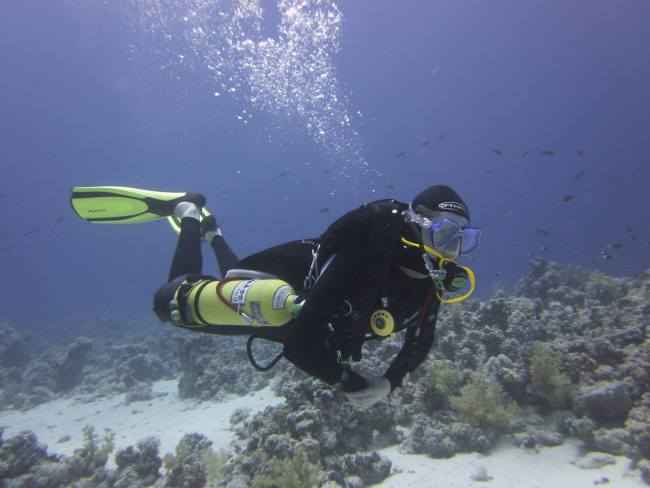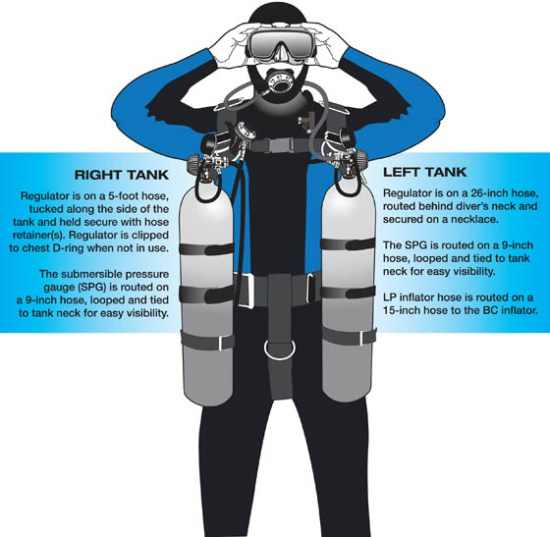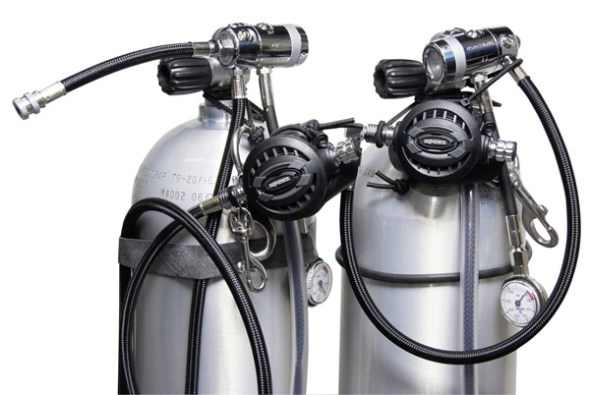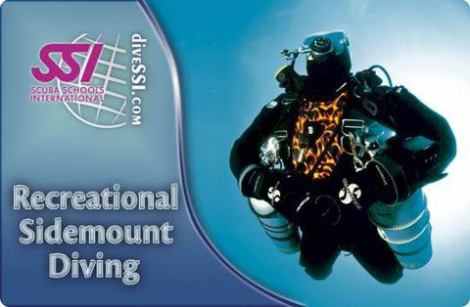Before anybody makes any comments, yes I have stolen the “Dummies guide to….” title from John Wiley & Sons, Inc but maybe in the future I actually find the time to write a full Dummies guide on this topic but until then I think the title for this article is very appropriate!
As professional divers we can have a tendency to get a bit carried away when we are writing articles or giving descriptions of the type of diving that we are so passionate about. The end result is that the reader / audience gets bombarded by terminology, jargon, slang and other code words which leaves them confused and exhausted. The aim of this article was to write a short article in basic diving language that not only the existing diver can understand but also to enable even the “diver to be” to have a basic insight into the topic of side mount diving.
Introducing Side mount diving.
If you are a keen scuba diver or have an interest in the area no doubt you may find you spend some of your free time reading the latest scuba magazines, browsing the scuba diving websites, looking at various scuba diving facebook groups. Does that sound familiar? If yes, you may have noticed that over the last two years the term “Side mount” has been popping its head up more and more frequently. Now, not everybody understands what “Side mount” is, let alone to want to try it, so let us here at Tekstreme Diving try to explain what it is all about and to let you know how you can give it a go.
What actually is Side mount diving?
It can be as simple as stating…
“Side mount is an scuba diving equipment configuration in which a diver is able to wear a tank on each side of his body instead of on his / her back”
Historically, side mount diving actually finds it origins from more extreme divers who wanted to explore the inner parts of cave and cavern systems. What they were finding is that with the normal scuba tanks attached to their back it made their overall size very large and cumbersome and it ultimately prevented them from moving through smaller spaces and penetrating deep into cave systems. So, they found a way to move the tanks from their backs to the sides of their bodies where they could easily detach them and swim though the smaller spaces with the tanks in front of their body.
Now the big question why has it moved over to mainstream diving?
The side mount configuration has tremendous adaptability and its many other advantages have been embraced by the recreational scuba diver of various different experience levels. Along with the advances in equipment development and production by leading manufactures side mount has become much more mainstream that you would realise. A few of the key features of side mount diving include:
- Less back strain
- Easier movements top side
- More manoeuvrability in the water
- Redundant gas supply
- Increased gas supply for longer dives
- Ability to extend no decompression dives
Where do the tanks go?
Side mount tanks lie parallel to the body, below the shoulders and alongside the hips. The diver has two separate and redundant sources of gas and will breathe first from one tank and then the other, switching back and forth between two independent regulators on airflex hoses throughout the dive. The clips on the bottom of the tanks are attached just below the hip, and the top of the tank is secured by a bungee system, which allows the tanks to sit alongside the body comfortably.
What about safety?
Whether diving a wreck, cave or open sea reef, everybody has recognized the safety and benefits of side mount diving. A side mount configuration gives a diver easier access to tank valves in an emergency; to be able to make gas shut downs or switch to a different breathing supply. Side mount configuration also makes it easier when divers need to swap in and out extra tanks in the situation of a low on gas or out of gas situation. The position of the tanks also gives the diver’s head greater range of motion for enhanced vision and comfort. With all the tanks being alongside the body rather than behind the body the diver can see all of their equipment easily.
Is it heavy?
Not at all, actually the complete opposite. One major advantage for side mount enthusiasts is simply the management of what can be a heavy load. It’s easy to see the appeal of a system that allows for the placement of tanks in the water, allowing him / her to enter the water in nothing more than a basic harness system. The tanks then clip in, but with the weight burden significantly reduced through buoyancy in the water. Of course, when the dive is done the process is easily reversed, allowing divers to exit the water with the same ease, simply passing their tanks out and then climbing out with just the harness still in place. Older divers, divers with pre existing back, knee, joint issues, and petite women are a few of the dive demographics increasingly embracing side mount diving for these very reasons.
Does it increase my dive time?
For divers who previously have felt that their dive times have been restricted by their higher breathing rates the bonus of side mount diving is massive. Of course by carrying two cylinders you have double the volume of gas that you would normally carry! Rather than having to dive with a larger, heavier 15 litre tank, now you can carry two 12 litre cylinders which you can put on in the water. No more heavy loads to carry, but loads of extra diving time gained!
Where can I try it out?
Like all forms of specialized diving, divers should seek training to learn about side mount diving. Both recreational and technical certification agencies now offer side mount training, making it easier to find an instructor and a dive centre that can offer such courses. More and more side mount divers are seen on boats and at dive sites; ask their opinion on why they choose to side mount and what safety features are critical to the dive environment. There’s a wealth of information out there just waiting for you to ask the questions.
So how long will it take to be a side mount diver?
It will likely take a few dives to balance the rig just right and to make the operation intuitive. Divers who want to get started in diving with side mount should take a structured course. Proper training will include removing a bottle underwater and swimming while pushing the tank in front of the body, donning tanks while floating at the surface, air sharing, gas management and deploying a surface marker. Working with an instructor will help the diver configure the finer parts of the rig, set up the tanks properly and make sure the trim is correct in-water. Courses are typically run over two days. How about make it as a combination with learning how to dive nitrox then you will really reap the benefits. Before you plan your diving holiday get in contact with your preferred diving center to check of they have the availability of side mount courses (not all dive centres can currently offer these side mount courses)
So lets have a go at cutting through some of the jargon….
A = Air flex hose
Light and extremely flexible, Airflex hoses carry an average lifespan that is 3 x longer than standard rubber hoses. Built with durability in mind, Airflex hoses are designed with excellent protection against abrasion, damage caused by UV rays and gear pinches. Their kink-resistant design means you can tie the Airflex hose into a knot and still have continuous air flow. Burst pressure is several times that of traditional rubber hoses and our Airflex hoses are suitable for use with any gas mixture.
B = Bungee
Shock cord that can be used for multiple functions in the scuba diving world. Found in side mount diving for attachment of the tank valve to the harness. Comes in various lengths and thicknesses.
C = Cave
A cave is defined as “A large hole that is formed by natural processes in the side of a cliff or hill or under the ground”
D = D – Ring
There are many different types of attachment rings on the market that the diver can attach to their harness to make tank attachment easy. Typically they are called D rings. The D-ring is the best way to create an attachment point on soft webbing. D-rings are available in various sizes and with differing angles. Made of marine grade 316 stainless steel they will last in fresh and salt water environment
E = Enriched Air Nitrox
Enriched Air Nitrox refers to any gas mixture composed of nitrogen and oxygen; this includes normal air which is approximately 78% nitrogen, 21% oxygen, and 1% other gases. However, in scuba diving, nitrox is normally differentiated and handled differently from air. The most common use of nitrox mixtures containing higher than normal levels of oxygen is in scuba, where the reduced percentage of nitrogen is advantageous in reducing nitrogen uptake in the body’s tissues and so extending the possible dive time, and/or reducing the risk of decompression sickness
F = Flexibility
The side mount diving approach offers divers significant benefits to the flexibility of their approach. Unlike back-mounted doubles, acquiring and transporting side mount suitable cylinders is often much more convenient and accessible. Side mount diving configuration allows the travelling diver to conduct technical and/or overhead environment dives without having to source traditional back-mounted twin cylinders
H = Hybrid Harness
Specialised side mount harnesses are available ‘off-the-shelf’ commercially. Some of these are designed specifically for side mounting only, but others are ‘hybrid’ designs, enabling the diver to swap between side mount and back-mounted cylinders, as needed.
N = No Decompression time
A no-decompression limit (NDL) is a time limit. No-decompression limits vary from dive to dive. A diver who stays underwater longer than the no-decompression limit for his dive can not ascend directly to the surface, but must pause periodically as he ascends to avoid a high risk of decompression sickness. A diver should never exceed a no-decompression limit without specialised training in decompression procedures.
P = Pressure gauge
To monitor breathing gas pressure in the diving cylinder, a diving regulator usually has a high pressure hose leading to a contents gauge (also called pressure gauge). The contents gauge is a pressure gauge measuring the gas pressure in the diving cylinder so the diver knows how much gas remains in the cylinder. It is also known as submersible pressure gauge or SPG. Typically in side mount configuration the pressure gauge is attached to a short, typically 6 inch hose.
R = Rig
The term given to the total set up of side mount equipment. To be exact it can be defined as “a device or piece of equipment designed for a particular purpose”
S = Streamline
Side mount diving configuration places the cylinders under the diver’s armpits, in line with their body. This decreases water resistance (improving air consumption and reducing fatigue) whilst also allowing the diver to pass through smaller restrictions than would otherwise be possible in back-mounted cylinders. The flexibility to remove tanks, and propel them in front, allows the diver to pass through very small passages and holes when penetration diving – being limited only by the size of their bodies and exposure protection
T = Trim
Underwater trim is the diver’s attitude in the water, in terms of balance and alignment with the direction of motion. Accurately controlled trim reduces swimming effort, as it reduces the sectional area of the diver passing through the water.
W = Wing
An inflatable buoyancy bladder known as a wing, that is fixed between the backplate and the diver. Wings come in various sizes with varying lift volumes. Types of include the Hollis SMS 50, or the Dive Rite Nomad
To summarise….
So hopefully in this short article we have managed to give you the reader a better understanding of what side mount diving is all about. It is not just for the hard core technical deep cave divers, quite the contrary, it is readily available and can be of great benefit to the diver beginning his / her scuba adventures. You don’t need fancy mix gas computers or the most expensive fins or to wear all black equipment, no, you simply need to have an interest in a different style of diving, enthusiasm and an open mind to learn. The world of side mount diving is out there for everybody.
If you would like to join one of our recreational safaris where we will be running side mount courses simply drop us an email via our website at: http://www.tekstremediving.com
The safari dates with current availability this year are:
15th August – 21st August 2014
10th October – 16th October 2014
There will be a maximum of 6 students per trip so contact us early to secure your place.












1 Comment
Sexy